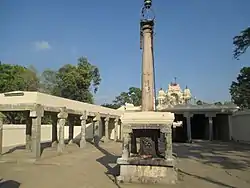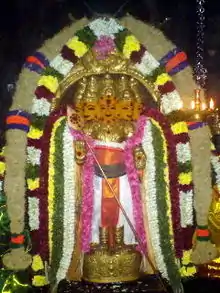Thirumuruganpoondi
Thirumuruganpoondi is a panchayat town in Tirupur District in the Indian state of Tamil Nadu. It is about 7 kilometres (4 mi) South from Tirupur city and 38 kilometres (24 mi) west from Coimbatore city. The place derives its name from the Thirumuruganatheeswar Temple present in the town.
Thirumuruganpoondi
Skandhamapuri pattanam | |
|---|---|
Town | |
 | |
| Coordinates: 11.1788°N 77.3145°E | |
| Country | |
| State | Tamil Nadu |
| District | Tirupur |
| Population (2001) | |
| • Total | 18,459 |
| Languages | |
| • Official | Tamil |
| Time zone | UTC+5:30 (IST) |
| Vehicle registration | TN 39 |
History
| Thirumuruganpoondi | |
|---|---|
 | |
| Religion | |
| Affiliation | Hinduism |
| District | Tirupur |
| Deity | Thirumuruganathaswamy |
| Location | |
| Location | Tamil Nadu, India |
| State | Tamil Nadu |
| Country | India |
 Location in Tamil Nadu | |
| Geographic coordinates | 11°9′N 77°18′E |
| Architecture | |
| Type | Dravidian architecture |
| Specifications | |
| Temple(s) | 15 |
| Monument(s) | . |
| Website | |
| www.thirumuruganpoondi.com | |
The name of the village is derived from the famous Murugan temple located here. In the last 8 years the development of Tirupur had reached Thirumuruganpoondi and soon this village will be submerged under the broader name of Tirupur.
The temple dates back to 9th Century. The origin of the temple is rooted in legendary antiquity. Soorapadma, the scourge of the gods with his retinue of demons, struck terror in the celestial world with his sudden depredations and campaigns. The persecuted gods approached Lord Siva and implored him to save their lives. Lord Siva sent Lord Subramanya with a huge army headed by the valiant Veerabhahu to destroy Soorapadma and his retinue. Lord Muruga accomplished the arduous task. But he was afflicted with the mortal sin of mass killing. In order to absolve himself he installed a Siva Linga in Thirumuruganpoondi and worshipped it. As Muruga himself adored Lord Siva, the latter assumed the appellation "Thirumuruganathaswamy" which means "Master of Muruga".
The holy shrine is also associated with Sundaramurthynayanar one of. the most celebrated saints of saivism. He did a pilgrimage to the holy shrines opf Siva in Kongunadu. Now Siva, The Lord of Thirumuruganpoondi who wanted to hear the saints melodies, compositions way laid Sundaramurthynayanar, in the guise of a hunter and robbed him of all his belongings and disappeared into the temple, Sundaramurthynayanar's sorrow burst out in the form of soul full song expressing his anguish and chiding the Lord of Thirmuruganpoondi that his divine presence in such a notorious place was mere mockery. Pleased with the poignancy of the compositions the lord ordered the return of all his belongings. Having understood the divine purpose behind the prank, Sundarar leaped with joy and glorified the Lord in ten songs. This episode is celebrated as an important festival called "Vedupari". The great sages such as Agasthya, Markendeya and Dhurvasa took to severe austerities and worshiped the Lord enshrined here. It is said that Durvasa brought the "Madhavi tree" from heaven and placed it here.
The Amman in this temple named as "Muyangupoon Mulaiyammai". Lord Muruga worshipped Siva Linga which was installed by him ad he did not pray to Amman. So amman got angry and she didn't come to the place. Lord Siva was not able to be there without Amman so he created a flood behind the statue and Siva Linga was about to be destroyed by the flood. Parvathi was not about to see that and she came down and hugged the Siva Linga to save it. So Lord siva was too happy. As parvathi hugged him he was happy so the amman named as "Muyangupoon Mulaiyammai".
Demographics
As of 2001 India census,[1] Thirumuruganpoondi had a population of 18,459. Males constitute 52% of the population and females 48%. A.Thirumuruganpoondi has an average literacy rate of 69%, higher than the national average of 59.5%; with 58% of the males and 42% of females literate. 12% of the population is under 6 years of age.
References
- "Census of India 2001: Data from the 2001 Census, including cities, villages and towns (Provisional)". Census Commission of India. Archived from the original on 16 June 2004. Retrieved 1 November 2008.

